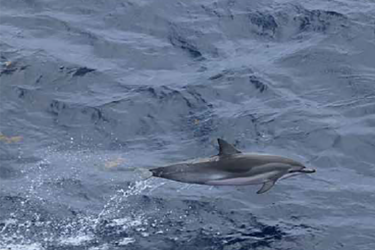Clymene Dolphin
Stenella clymene
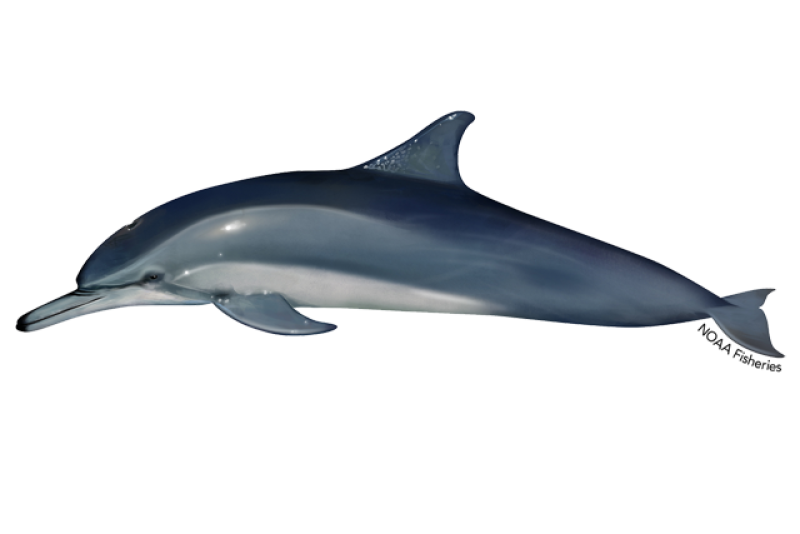
Protected Status
Quick Facts
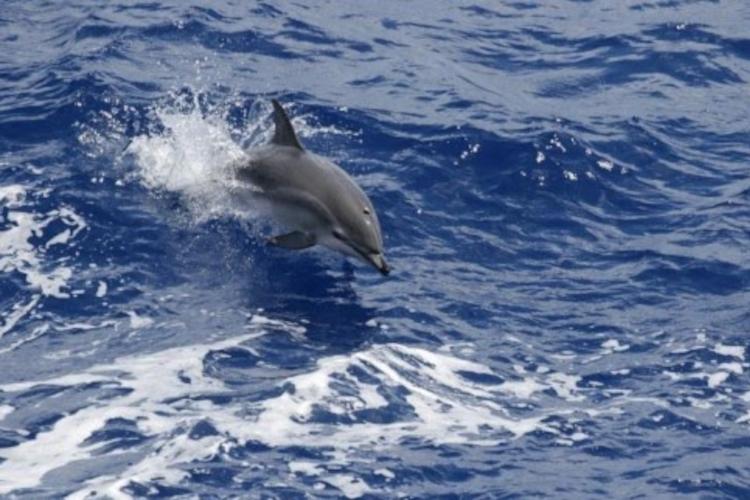 A Clymene dolphin observed during the AMAPPS Summer 2021 research survey. NMFS MMPA Permit No.21938. Credit: NOAA Fisheries/Mary Applegate
A Clymene dolphin observed during the AMAPPS Summer 2021 research survey. NMFS MMPA Permit No.21938. Credit: NOAA Fisheries/Mary Applegate
A Clymene dolphin observed during the AMAPPS Summer 2021 research survey. NMFS MMPA Permit No.21938. Credit: NOAA Fisheries/Mary Applegate
About the Species
 A Clymene dolphin observed during the AMAPPS Summer 2021 research survey. NMFS MMPA Permit No.21938. Credit: NOAA Fisheries/Mary Applegate
A Clymene dolphin observed during the AMAPPS Summer 2021 research survey. NMFS MMPA Permit No.21938. Credit: NOAA Fisheries/Mary Applegate
A Clymene dolphin observed during the AMAPPS Summer 2021 research survey. NMFS MMPA Permit No.21938. Credit: NOAA Fisheries/Mary Applegate
Clymene dolphins are found in the deep, tropical waters of the Atlantic Ocean. They are the smallest dolphin in the genus Stenella, which also includes spinner dolphins, Atlantic spotted dolphins, pantropical spotted dolphins, and striped dolphins.
Clymene dolphins are also known as "short-snouted spinner dolphins" because they often spin while jumping out of the water.
Clymene dolphins, like all marine mammals, are protected under the Marine Mammal Protection Act. NOAA Fisheries and its partners are working to conserve Clymene dolphins and further our understanding of this species through research and conservation activities.
Population Status
NOAA Fisheries estimates population size in its stock assessment reports.
The worldwide population of Clymene dolphins is unknown.
To manage Clymene dolphins in U.S. waters, we have divided them into two stocks: the Gulf of America* (formerly Gulf of Mexico) stock and the western North Atlantic stock. Based on the most recent surveys, our scientists estimate that there are about 513 dolphins in the northern Gulf of America stock. Estimates for this stock have varied widely over time. The number of dolphins in the western North Atlantic stock is 21,778.
Appearance
Clymene dolphins are about six to 6.5 feet long and weigh about 165 to 200 pounds. They have a streamlined body with a tall, curved dorsal fin located midway down their back. Their beaks are moderately short. Like other cetaceans, their head has a distinctive "melon," a rounded forehead that collects sounds from the environment.
Clymene dolphins have a three-part color pattern with a dark gray back, light gray sides, and a white or pale gray underside. They have distinct black lips that can look like a mustache, as well as a dark line that extends across the top of their beak. They also have 39 to 52 pairs of small, cone-shaped teeth in each jaw.
Behavior and Diet
Clymene dolphins are usually found in groups of 60 to 80 individuals but sometimes travel in groups of up to 200. These groups are sometimes organized by age and sex.
Clymene dolphins are often described as “acrobatic” swimmers because they often leap out of the water, spin in the air, and “surf” in the waves created by vessels. They sometimes interact with other cetacean species, such as common dolphins off West Africa and spinner dolphins in the Caribbean Sea.
Clymene dolphins dive to catch small fish and cephalopods (e.g., squid and octopi). They sometimes feed at night to catch prey that migrate towards the water’s surface after dark.
Where They Live
Clymene dolphins are found in deep tropical, subtropical, and temperate waters throughout the Atlantic Ocean. Their range includes the waters of the northwestern Atlantic Ocean (New Jersey), Gulf of America, Caribbean Sea, southern Brazil, and West Africa (Mauritania to Angola).
Clymene dolphins prefer deep waters off the continental shelf (the edge of a continent below the ocean’s surface). They are usually found in oceanic waters 820 to 16,400 feet deep.
Lifespan & Reproduction
The estimated lifespan of Clymene dolphins is unknown, and little is known about their reproductive habits. These dolphins reach sexual maturity once they are 6 feet long. Females give birth to a single calf that weighs about 22 pounds.
Threats
Entanglement
One of the main threats to Clymene dolphins becoming entangled or captured in commercial fishing gear. Specifically, they have been caught in gillnet operations in Venezuela and tuna purse seine nets off the coast of West Africa. Entanglement during these interactions can injure or kill dolphins.
Ocean Noise
Underwater noise pollution interrupts the normal behavior of Clymene dolphins that rely on sound to communicate and echolocate. If loud enough, noise can cause permanent or temporary hearing loss. Noise interference from vessels, as well as industrial and military activities, disturbs Clymene dolphins’ feeding, communication, and orientation.
Hunting
Whalers in the Caribbean Sea (Lesser Antilles) sometimes target and hunt Clymene dolphins using harpoons for meat and oil.
*Executive Order 14172, “Restoring Names That Honor American Greatness” (Jan. 20, 2025), directs that the Gulf of Mexico be renamed the Gulf of America. Gulf of America references in this website refer to the same area as the Gulf of Mexico in the applicable regulations under 50 CFR parts 216–219, 222–226, and 600–699. The name change did not result in any changes to, and had no effect on the applicability or enforceability of, any existing regulations. This website continues to use “Gulf of Mexico” when quoting statutes, existing regulations, or previously published materials.
Scientific Classification
| Kingdom | Animalia | Phylum | Chordata | Class | Mammalia | Order | Cetacea | Family | Delphinidae | Genus | Stenella | Species | clymene |
|---|
Last updated by NOAA Fisheries on 04/24/2025
What We Do
Conservation & Management
NOAA Fisheries is committed to protecting Clymene dolphins. Targeted management actions taken to secure protections for these dolphins include:
- Overseeing marine mammal health and stranding response
- Addressing ocean noise
- Educating the public about Clymene dolphins and the threats they face
Science
Our research projects have discovered new aspects of Clymene dolphin biology, behavior, and ecology and helped us better understand the challenges that all Clymene dolphins face. Our work includes:
- Stock assessments
- Monitoring population abundance and distribution
How You Can Help
Keep Your Distance
Be responsible when viewing marine life in the wild. Observe all dolphins and porpoises from a safe distance of at least 50 yards and limit your time spent observing to 30 minutes or less.
Report Marine Life in Distress
Report a sick, injured, entangled, stranded, or dead animal to make sure professional responders and scientists know about it and can take appropriate action. Numerous organizations around the country are trained and ready to respond. Never approach or try to save an injured or entangled animal yourself—it can be dangerous to both the animal and you.
Learn who you should contact when you encounter a stranded or injured marine animal
Report a Violation
Call the NOAA Fisheries Enforcement Hotline at (800) 853-1964 to report a federal marine resource violation. This hotline is available 24 hours a day, 7 days a week for anyone in the United States.
You may also contact your closest NOAA Office of Law Enforcement field office during regular business hours.
Don't Feed Wild Dolphins
Dolphins fed by humans lose their natural wariness and learn to associate people with food, causing them to beg for handouts and take bait and catch directly from fishing gear. This puts them at risk from vessel strikes and becoming entangled in or ingesting fishing gear. Dolphins may teach these behaviors to their young, thereby putting them at risk.
More on protecting wild dolphins and admiring them from a distance
Featured News
 Rice's Whale. Credit: NOAA Fisheries
Rice's Whale. Credit: NOAA Fisheries
Protecting Species While Planning for Offshore Wind Development in the U.S. Gulf of Mexico
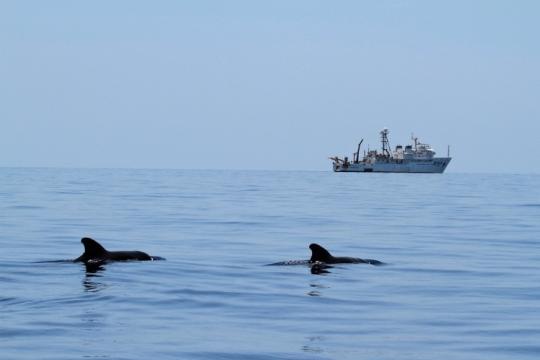 Pilot whales surface near the NOAA Ship Gordon Gunter. Credit: NOAA Fisheries/Melody Baran (Permit # 14450)
Pilot whales surface near the NOAA Ship Gordon Gunter. Credit: NOAA Fisheries/Melody Baran (Permit # 14450)
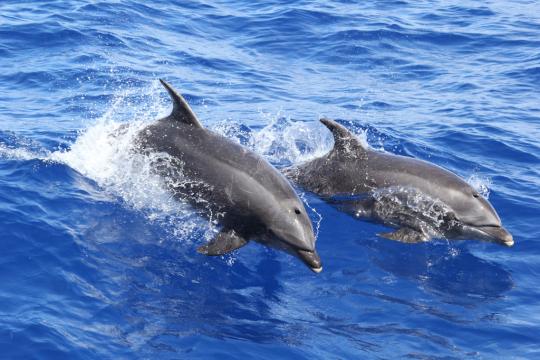 Pair of bottlenose dolphins. Credit: NOAA Pacific Islands Fisheries Science Center/Lisa Morse.
Pair of bottlenose dolphins. Credit: NOAA Pacific Islands Fisheries Science Center/Lisa Morse.
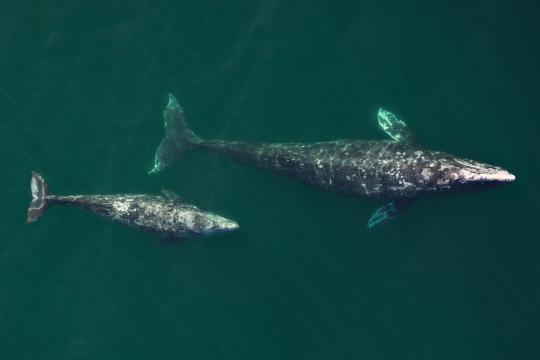 Gray whales were nearly hunted to extinction by commercial whaling. Protections under the MMPA, ESA, and the end of commercial whaling have allowed the species to recover. Credit: NOAA Fisheries (Permit #19091).
Gray whales were nearly hunted to extinction by commercial whaling. Protections under the MMPA, ESA, and the end of commercial whaling have allowed the species to recover. Credit: NOAA Fisheries (Permit #19091).
Celebrating 50 Years of the Marine Mammal Protection Act
Management Overview
The Clymene dolphin is protected throughout its range under the Marine Mammal Protection Act.
Additionally, the Clymene dolphin is listed under:
- Appendix II of the Convention on International Trade in Endangered Species of Wild Fauna and Flora (CITES)
Annex II of the Protocol for Specially Protected Areas and Wildlife (SPAW)
Conservation Efforts
Overseeing Marine Mammal Health and Stranding Response
We work with volunteer networks in all coastal states to respond to marine mammal strandings including all dolphins and porpoises. When stranded animals are found alive, NOAA Fisheries and our partners assess the animal’s health and determine the best course of action. When stranded animals are found dead, our scientists work to understand and investigate the cause of death. Although the cause often remains unknown, scientists can sometimes attribute strandings to disease, harmful algal blooms, vessel strikes, fishing gear entanglements, pollution exposure, and underwater noise. Some strandings can serve as indicators of ocean health, giving insight into larger environmental issues that may also have implications for human health and welfare.
Learn more about the Marine Mammal Health and Stranding Response Program
Marine Mammal Unusual Mortality Events
Clymene dolphins have been part of a declared unusual mortality event in the past. Under the Marine Mammal Protection Act, an unusual mortality event is defined as "a stranding that is unexpected; involves a significant die-off of any marine mammal population; and demands immediate response." To understand the health of marine mammal populations, scientists study unusual mortality events.
Get information on active and past UMEs
Get an overview of marine mammal UMEs
Addressing Ocean Noise
Underwater noise threatens dolphin populations, interrupting their normal behavior and driving them away from areas important to their survival. Increasing evidence suggests that exposure to intense underwater sound in some settings may cause some dolphins to strand and ultimately die. NOAA Fisheries is investigating all aspects of acoustic communication and hearing in marine animals, as well as the effects of sound on dolphin behavior and hearing. In 2018, we revised marine mammal acoustic technical guidance for assessing the effects of human-caused sound on marine mammal hearing.
Dolphin-Safe/Tuna Tracking and Verification Program
Dolphins, like other marine mammals, may become bycatch in fisheries. Some species of tuna are known to aggregate beneath schools of certain dolphin stocks. In some parts of the world, this close association led to the fishing practice of encircling a dolphin school to capture the tuna concentrated below. The Dolphin Protection Consumer Information Act established a national tuna tracking program to ensure that tuna imported into the United States meets certain requirements to ensure the safety of dolphins during tuna fishing operations.
Learn more about the Dolphin-Safe/Tuna Tracking and Verification Program
Regulatory History
All marine mammals, including Clymene dolphins, are protected in the United States under the MMPA.
Key Actions and Documents
Last updated by NOAA Fisheries on 04/24/2025
Science Overview
NOAA Fisheries conducts various research activities on the biology, behavior, and ecology of Clymene dolphins. The results of this research are used to inform management decisions for this species.
Stock Assessments
Determining the size of Clymene dolphin populations helps resource managers determine the success of conservation measures. Our scientists collect population information and present the data in annual stock assessment reports.
Monitoring Population Abundance and Distribution
Scientists observe Clymene dolphins to record their numbers and distribution. By comparing numbers collected over multiple years, scientists can look for trends—i.e., whether the population is increasing, decreasing, or remaining stable during a given period.
More Information
Recent Science Blogs
Last updated by NOAA Fisheries on 04/24/2025
Outreach & Education
Dolphin Friendly Fishing Tips Sign
This sign is often posted near boat ramps, piers, docks, marinas, and waterfront parks.
Protect Wild Dolphins Sign
This sign is often posted near boat ramps, piers, docks, marinas, and waterfront parks.
Don't Feed Wild Dolphin Sign
This sign is often posted near boat ramps, piers, docks, marinas, and waterfront parks.
Last updated by NOAA Fisheries on 04/24/2025




